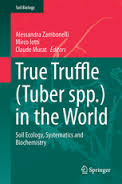Genetic diversity and origins of the homoploid allopolyploid hybrid Phytophthora× alni. J Aguayo, F Halkett, C Husson, ZÁ Nagy, A Szigethy, J Bakonyi, P Frey, … Applied and Environmental Microbiology, AEM. 02221-16
Abstract
Assessing the process that gives rise to hybrid pathogens is central to understand the evolution of emerging plant diseases. Phytophthora ×alni, a pathogen of alder, results from the homoploid hybridization of two related species, Phytophthora uniformis and Phytophthora ×multiformis. Describing genetic characteristics of P. ×alni should help understanding how reproductive mechanisms and historical processes shaped the population structure of this emerging hybrid pathogen. The population genetic structure of P. ×alni and the relationship with its parental species was investigated using twelve microsatellites and one mitochondrial DNA (mtDNA) marker on a European collection of 379 isolates. Populations of P. ×alni were dominated by one multilocus genotype (MLG). The frequency of this dominant MLG increased after the disease emergence together with a decline in diversity, suggesting that it was favoured by a genetic mechanism such as drift or selection. Combined microsatellite and mtDNA results confirmed that P. ×alnioriginated from multiple hybridization events that involved different genotypes of the progenitors. Our detailed analyses point to a geographic structure which mirrors that observed for P. uniformis in Europe. The study provides more insights on the contribution of P. uniformis, an invasive species in Europe, to the emergence of Phytophthora-induced alder decline.
Importance: Our study describes an original approach to assess the population genetics of polyploid organisms using microsatellite markers. By studying the parental subgenomes present in the interspecific hybrid Phytophthora ×alni we were able to assess the geographical and temporal structure of European populations of the hybrid, shedding new light on the evolution of an emerging plant pathogen. In turn, the study of the parental subgenomes permitted us to assess some genetic characteristics of the parental species of Phytophthora ×alni, Phytophthora uniformis and Phytophthora×multiformis, which are seldom sampled in the nature. The subgenomes found in Phytophthora ×alni represent a picture of the “fossilized” diversity of the parental species.

